COIT20249 Report: Evaluating 3D Printing in Information Technology
VerifiedAdded on 2023/06/14
|17
|4215
|337
Report
AI Summary
This report assesses the potential of 3D printing technology for a manufacturing organization specializing in printers and computers. It defines 3D printing, highlights recent developments, and examines its uses in manufacturing and medical industries. The report evaluates three 3D printing applications for business expansion in Australia, considering advantages, disadvantages, ethical, social, and legal aspects. Recommendations are provided to address potential issues, focusing on leveraging Nano Dimensions' technology for PCB prototyping, standardizing computer boards, and creating small-scale prototypes. The analysis includes discussions on cost reduction, customization, and efficient manufacturing processes, ultimately advising on the strategic implementation of 3D printing to enhance business operations and innovation.
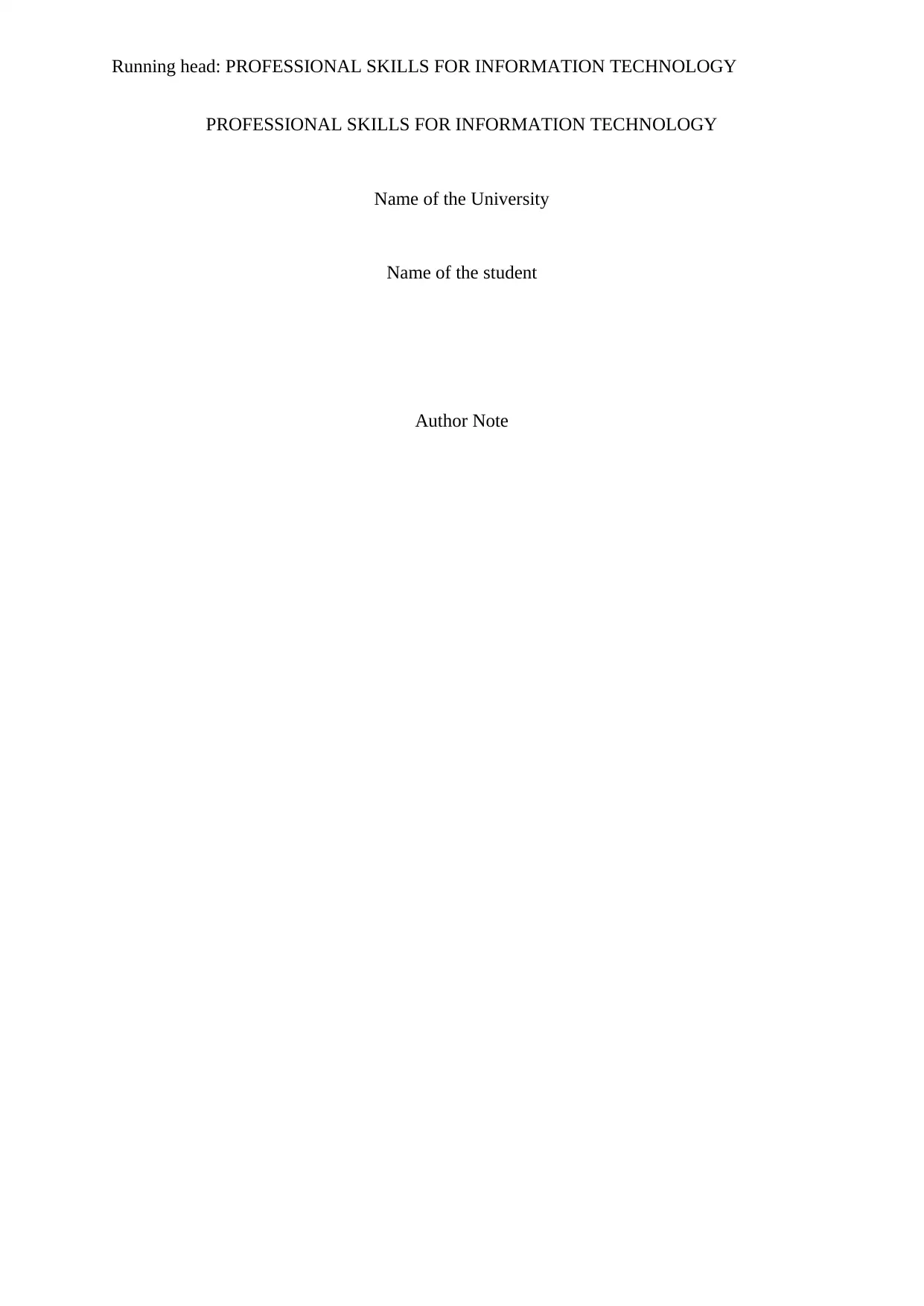
Running head: PROFESSIONAL SKILLS FOR INFORMATION TECHNOLOGY
PROFESSIONAL SKILLS FOR INFORMATION TECHNOLOGY
Name of the University
Name of the student
Author Note
PROFESSIONAL SKILLS FOR INFORMATION TECHNOLOGY
Name of the University
Name of the student
Author Note
Paraphrase This Document
Need a fresh take? Get an instant paraphrase of this document with our AI Paraphraser
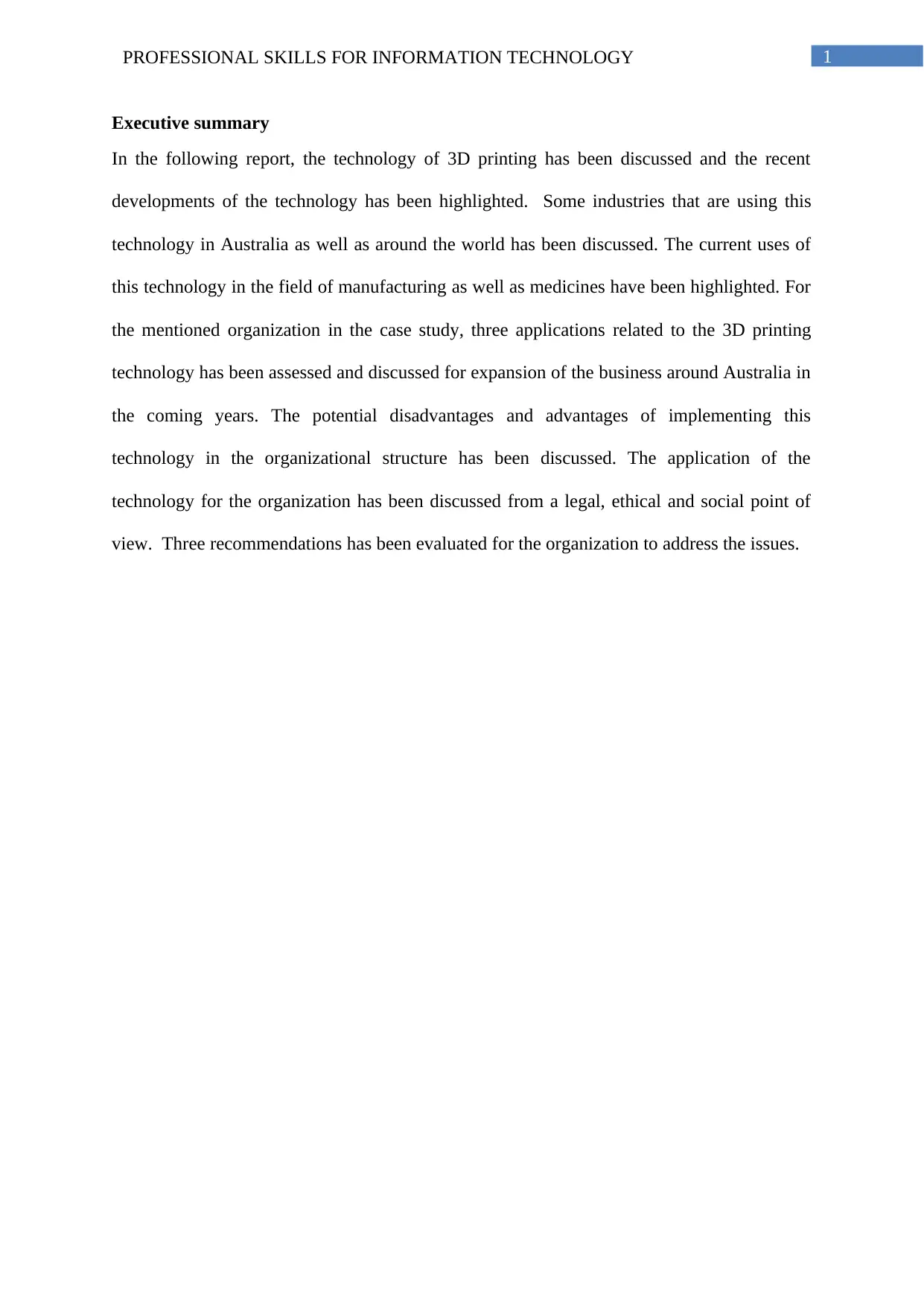
1PROFESSIONAL SKILLS FOR INFORMATION TECHNOLOGY
Executive summary
In the following report, the technology of 3D printing has been discussed and the recent
developments of the technology has been highlighted. Some industries that are using this
technology in Australia as well as around the world has been discussed. The current uses of
this technology in the field of manufacturing as well as medicines have been highlighted. For
the mentioned organization in the case study, three applications related to the 3D printing
technology has been assessed and discussed for expansion of the business around Australia in
the coming years. The potential disadvantages and advantages of implementing this
technology in the organizational structure has been discussed. The application of the
technology for the organization has been discussed from a legal, ethical and social point of
view. Three recommendations has been evaluated for the organization to address the issues.
Executive summary
In the following report, the technology of 3D printing has been discussed and the recent
developments of the technology has been highlighted. Some industries that are using this
technology in Australia as well as around the world has been discussed. The current uses of
this technology in the field of manufacturing as well as medicines have been highlighted. For
the mentioned organization in the case study, three applications related to the 3D printing
technology has been assessed and discussed for expansion of the business around Australia in
the coming years. The potential disadvantages and advantages of implementing this
technology in the organizational structure has been discussed. The application of the
technology for the organization has been discussed from a legal, ethical and social point of
view. Three recommendations has been evaluated for the organization to address the issues.
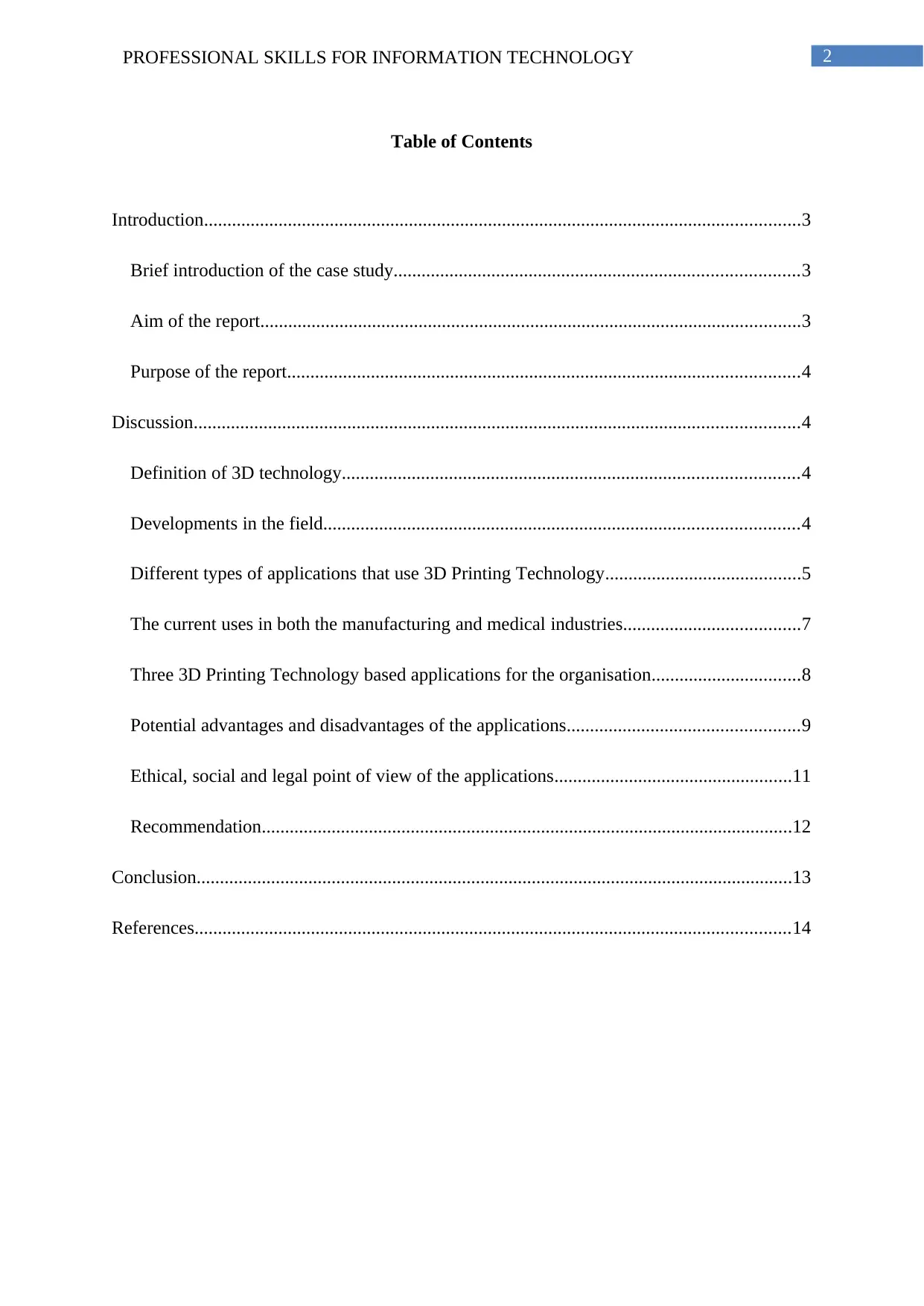
2PROFESSIONAL SKILLS FOR INFORMATION TECHNOLOGY
Table of Contents
Introduction................................................................................................................................3
Brief introduction of the case study.......................................................................................3
Aim of the report....................................................................................................................3
Purpose of the report..............................................................................................................4
Discussion..................................................................................................................................4
Definition of 3D technology..................................................................................................4
Developments in the field......................................................................................................4
Different types of applications that use 3D Printing Technology..........................................5
The current uses in both the manufacturing and medical industries......................................7
Three 3D Printing Technology based applications for the organisation................................8
Potential advantages and disadvantages of the applications..................................................9
Ethical, social and legal point of view of the applications...................................................11
Recommendation..................................................................................................................12
Conclusion................................................................................................................................13
References................................................................................................................................14
Table of Contents
Introduction................................................................................................................................3
Brief introduction of the case study.......................................................................................3
Aim of the report....................................................................................................................3
Purpose of the report..............................................................................................................4
Discussion..................................................................................................................................4
Definition of 3D technology..................................................................................................4
Developments in the field......................................................................................................4
Different types of applications that use 3D Printing Technology..........................................5
The current uses in both the manufacturing and medical industries......................................7
Three 3D Printing Technology based applications for the organisation................................8
Potential advantages and disadvantages of the applications..................................................9
Ethical, social and legal point of view of the applications...................................................11
Recommendation..................................................................................................................12
Conclusion................................................................................................................................13
References................................................................................................................................14
⊘ This is a preview!⊘
Do you want full access?
Subscribe today to unlock all pages.

Trusted by 1+ million students worldwide
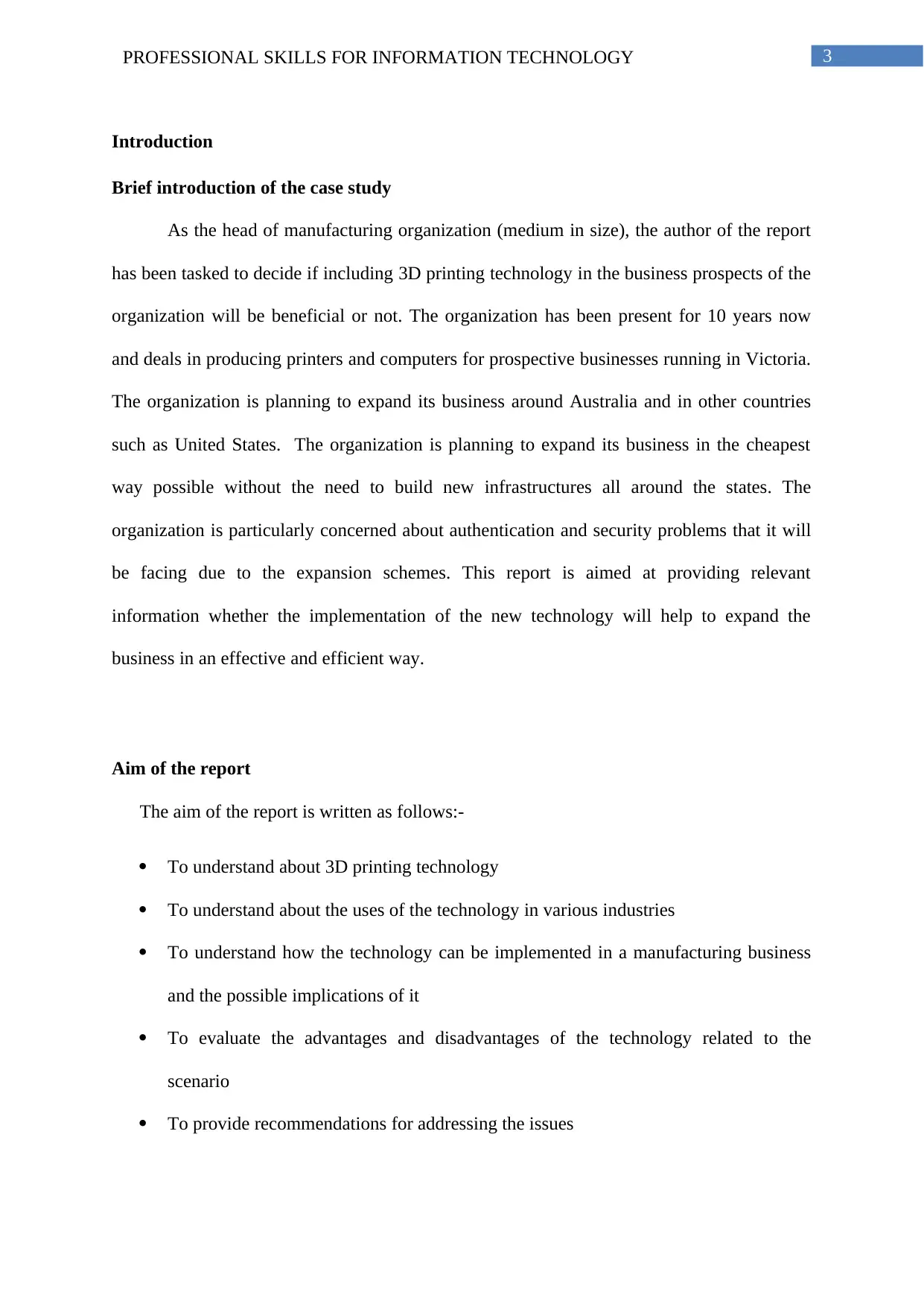
3PROFESSIONAL SKILLS FOR INFORMATION TECHNOLOGY
Introduction
Brief introduction of the case study
As the head of manufacturing organization (medium in size), the author of the report
has been tasked to decide if including 3D printing technology in the business prospects of the
organization will be beneficial or not. The organization has been present for 10 years now
and deals in producing printers and computers for prospective businesses running in Victoria.
The organization is planning to expand its business around Australia and in other countries
such as United States. The organization is planning to expand its business in the cheapest
way possible without the need to build new infrastructures all around the states. The
organization is particularly concerned about authentication and security problems that it will
be facing due to the expansion schemes. This report is aimed at providing relevant
information whether the implementation of the new technology will help to expand the
business in an effective and efficient way.
Aim of the report
The aim of the report is written as follows:-
To understand about 3D printing technology
To understand about the uses of the technology in various industries
To understand how the technology can be implemented in a manufacturing business
and the possible implications of it
To evaluate the advantages and disadvantages of the technology related to the
scenario
To provide recommendations for addressing the issues
Introduction
Brief introduction of the case study
As the head of manufacturing organization (medium in size), the author of the report
has been tasked to decide if including 3D printing technology in the business prospects of the
organization will be beneficial or not. The organization has been present for 10 years now
and deals in producing printers and computers for prospective businesses running in Victoria.
The organization is planning to expand its business around Australia and in other countries
such as United States. The organization is planning to expand its business in the cheapest
way possible without the need to build new infrastructures all around the states. The
organization is particularly concerned about authentication and security problems that it will
be facing due to the expansion schemes. This report is aimed at providing relevant
information whether the implementation of the new technology will help to expand the
business in an effective and efficient way.
Aim of the report
The aim of the report is written as follows:-
To understand about 3D printing technology
To understand about the uses of the technology in various industries
To understand how the technology can be implemented in a manufacturing business
and the possible implications of it
To evaluate the advantages and disadvantages of the technology related to the
scenario
To provide recommendations for addressing the issues
Paraphrase This Document
Need a fresh take? Get an instant paraphrase of this document with our AI Paraphraser
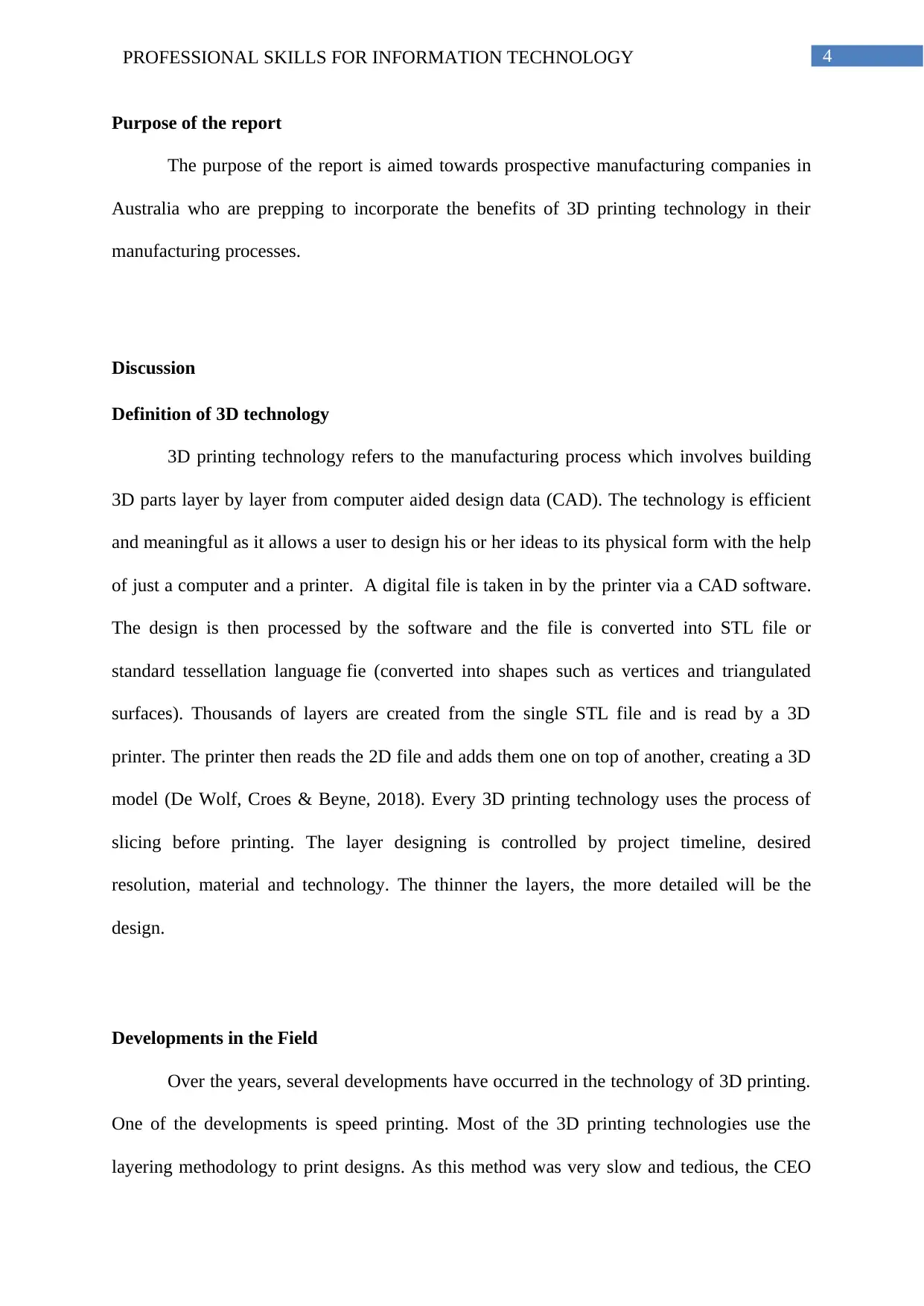
4PROFESSIONAL SKILLS FOR INFORMATION TECHNOLOGY
Purpose of the report
The purpose of the report is aimed towards prospective manufacturing companies in
Australia who are prepping to incorporate the benefits of 3D printing technology in their
manufacturing processes.
Discussion
Definition of 3D technology
3D printing technology refers to the manufacturing process which involves building
3D parts layer by layer from computer aided design data (CAD). The technology is efficient
and meaningful as it allows a user to design his or her ideas to its physical form with the help
of just a computer and a printer. A digital file is taken in by the printer via a CAD software.
The design is then processed by the software and the file is converted into STL file or
standard tessellation language fie (converted into shapes such as vertices and triangulated
surfaces). Thousands of layers are created from the single STL file and is read by a 3D
printer. The printer then reads the 2D file and adds them one on top of another, creating a 3D
model (De Wolf, Croes & Beyne, 2018). Every 3D printing technology uses the process of
slicing before printing. The layer designing is controlled by project timeline, desired
resolution, material and technology. The thinner the layers, the more detailed will be the
design.
Developments in the Field
Over the years, several developments have occurred in the technology of 3D printing.
One of the developments is speed printing. Most of the 3D printing technologies use the
layering methodology to print designs. As this method was very slow and tedious, the CEO
Purpose of the report
The purpose of the report is aimed towards prospective manufacturing companies in
Australia who are prepping to incorporate the benefits of 3D printing technology in their
manufacturing processes.
Discussion
Definition of 3D technology
3D printing technology refers to the manufacturing process which involves building
3D parts layer by layer from computer aided design data (CAD). The technology is efficient
and meaningful as it allows a user to design his or her ideas to its physical form with the help
of just a computer and a printer. A digital file is taken in by the printer via a CAD software.
The design is then processed by the software and the file is converted into STL file or
standard tessellation language fie (converted into shapes such as vertices and triangulated
surfaces). Thousands of layers are created from the single STL file and is read by a 3D
printer. The printer then reads the 2D file and adds them one on top of another, creating a 3D
model (De Wolf, Croes & Beyne, 2018). Every 3D printing technology uses the process of
slicing before printing. The layer designing is controlled by project timeline, desired
resolution, material and technology. The thinner the layers, the more detailed will be the
design.
Developments in the Field
Over the years, several developments have occurred in the technology of 3D printing.
One of the developments is speed printing. Most of the 3D printing technologies use the
layering methodology to print designs. As this method was very slow and tedious, the CEO
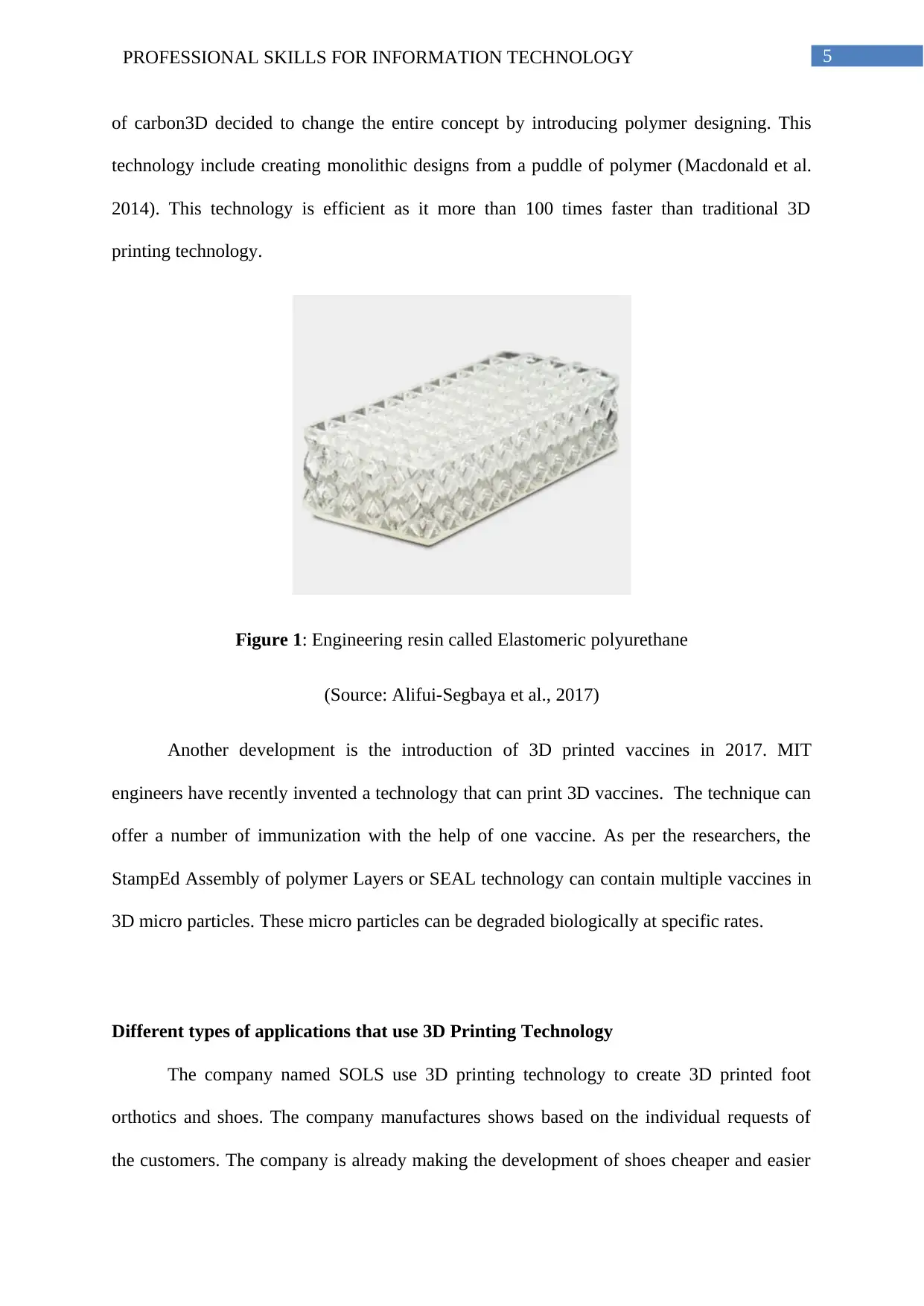
5PROFESSIONAL SKILLS FOR INFORMATION TECHNOLOGY
of carbon3D decided to change the entire concept by introducing polymer designing. This
technology include creating monolithic designs from a puddle of polymer (Macdonald et al.
2014). This technology is efficient as it more than 100 times faster than traditional 3D
printing technology.
Figure 1: Engineering resin called Elastomeric polyurethane
(Source: Alifui-Segbaya et al., 2017)
Another development is the introduction of 3D printed vaccines in 2017. MIT
engineers have recently invented a technology that can print 3D vaccines. The technique can
offer a number of immunization with the help of one vaccine. As per the researchers, the
StampEd Assembly of polymer Layers or SEAL technology can contain multiple vaccines in
3D micro particles. These micro particles can be degraded biologically at specific rates.
Different types of applications that use 3D Printing Technology
The company named SOLS use 3D printing technology to create 3D printed foot
orthotics and shoes. The company manufactures shows based on the individual requests of
the customers. The company is already making the development of shoes cheaper and easier
of carbon3D decided to change the entire concept by introducing polymer designing. This
technology include creating monolithic designs from a puddle of polymer (Macdonald et al.
2014). This technology is efficient as it more than 100 times faster than traditional 3D
printing technology.
Figure 1: Engineering resin called Elastomeric polyurethane
(Source: Alifui-Segbaya et al., 2017)
Another development is the introduction of 3D printed vaccines in 2017. MIT
engineers have recently invented a technology that can print 3D vaccines. The technique can
offer a number of immunization with the help of one vaccine. As per the researchers, the
StampEd Assembly of polymer Layers or SEAL technology can contain multiple vaccines in
3D micro particles. These micro particles can be degraded biologically at specific rates.
Different types of applications that use 3D Printing Technology
The company named SOLS use 3D printing technology to create 3D printed foot
orthotics and shoes. The company manufactures shows based on the individual requests of
the customers. The company is already making the development of shoes cheaper and easier
⊘ This is a preview!⊘
Do you want full access?
Subscribe today to unlock all pages.

Trusted by 1+ million students worldwide
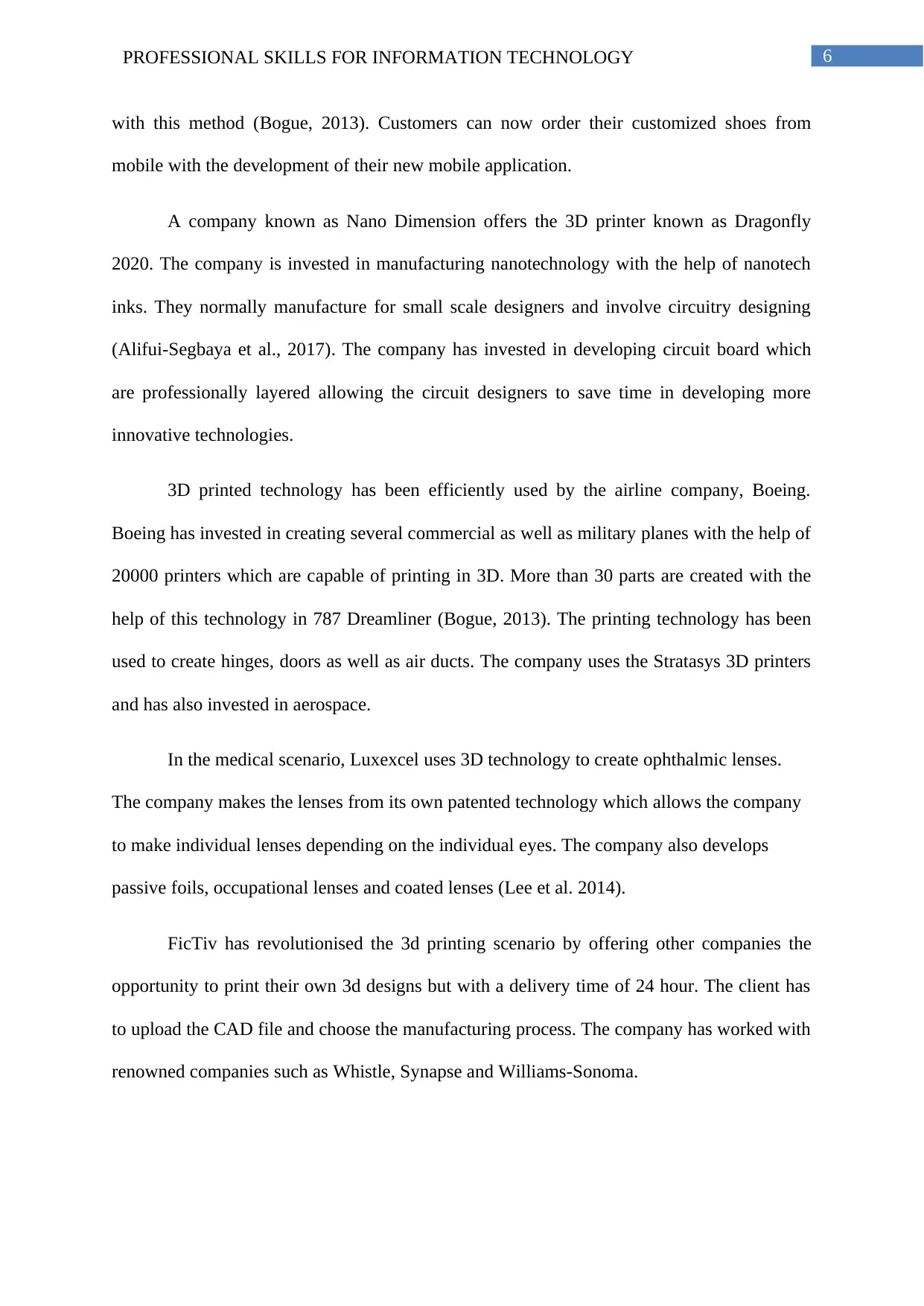
6PROFESSIONAL SKILLS FOR INFORMATION TECHNOLOGY
with this method (Bogue, 2013). Customers can now order their customized shoes from
mobile with the development of their new mobile application.
A company known as Nano Dimension offers the 3D printer known as Dragonfly
2020. The company is invested in manufacturing nanotechnology with the help of nanotech
inks. They normally manufacture for small scale designers and involve circuitry designing
(Alifui-Segbaya et al., 2017). The company has invested in developing circuit board which
are professionally layered allowing the circuit designers to save time in developing more
innovative technologies.
3D printed technology has been efficiently used by the airline company, Boeing.
Boeing has invested in creating several commercial as well as military planes with the help of
20000 printers which are capable of printing in 3D. More than 30 parts are created with the
help of this technology in 787 Dreamliner (Bogue, 2013). The printing technology has been
used to create hinges, doors as well as air ducts. The company uses the Stratasys 3D printers
and has also invested in aerospace.
In the medical scenario, Luxexcel uses 3D technology to create ophthalmic lenses.
The company makes the lenses from its own patented technology which allows the company
to make individual lenses depending on the individual eyes. The company also develops
passive foils, occupational lenses and coated lenses (Lee et al. 2014).
FicTiv has revolutionised the 3d printing scenario by offering other companies the
opportunity to print their own 3d designs but with a delivery time of 24 hour. The client has
to upload the CAD file and choose the manufacturing process. The company has worked with
renowned companies such as Whistle, Synapse and Williams-Sonoma.
with this method (Bogue, 2013). Customers can now order their customized shoes from
mobile with the development of their new mobile application.
A company known as Nano Dimension offers the 3D printer known as Dragonfly
2020. The company is invested in manufacturing nanotechnology with the help of nanotech
inks. They normally manufacture for small scale designers and involve circuitry designing
(Alifui-Segbaya et al., 2017). The company has invested in developing circuit board which
are professionally layered allowing the circuit designers to save time in developing more
innovative technologies.
3D printed technology has been efficiently used by the airline company, Boeing.
Boeing has invested in creating several commercial as well as military planes with the help of
20000 printers which are capable of printing in 3D. More than 30 parts are created with the
help of this technology in 787 Dreamliner (Bogue, 2013). The printing technology has been
used to create hinges, doors as well as air ducts. The company uses the Stratasys 3D printers
and has also invested in aerospace.
In the medical scenario, Luxexcel uses 3D technology to create ophthalmic lenses.
The company makes the lenses from its own patented technology which allows the company
to make individual lenses depending on the individual eyes. The company also develops
passive foils, occupational lenses and coated lenses (Lee et al. 2014).
FicTiv has revolutionised the 3d printing scenario by offering other companies the
opportunity to print their own 3d designs but with a delivery time of 24 hour. The client has
to upload the CAD file and choose the manufacturing process. The company has worked with
renowned companies such as Whistle, Synapse and Williams-Sonoma.
Paraphrase This Document
Need a fresh take? Get an instant paraphrase of this document with our AI Paraphraser
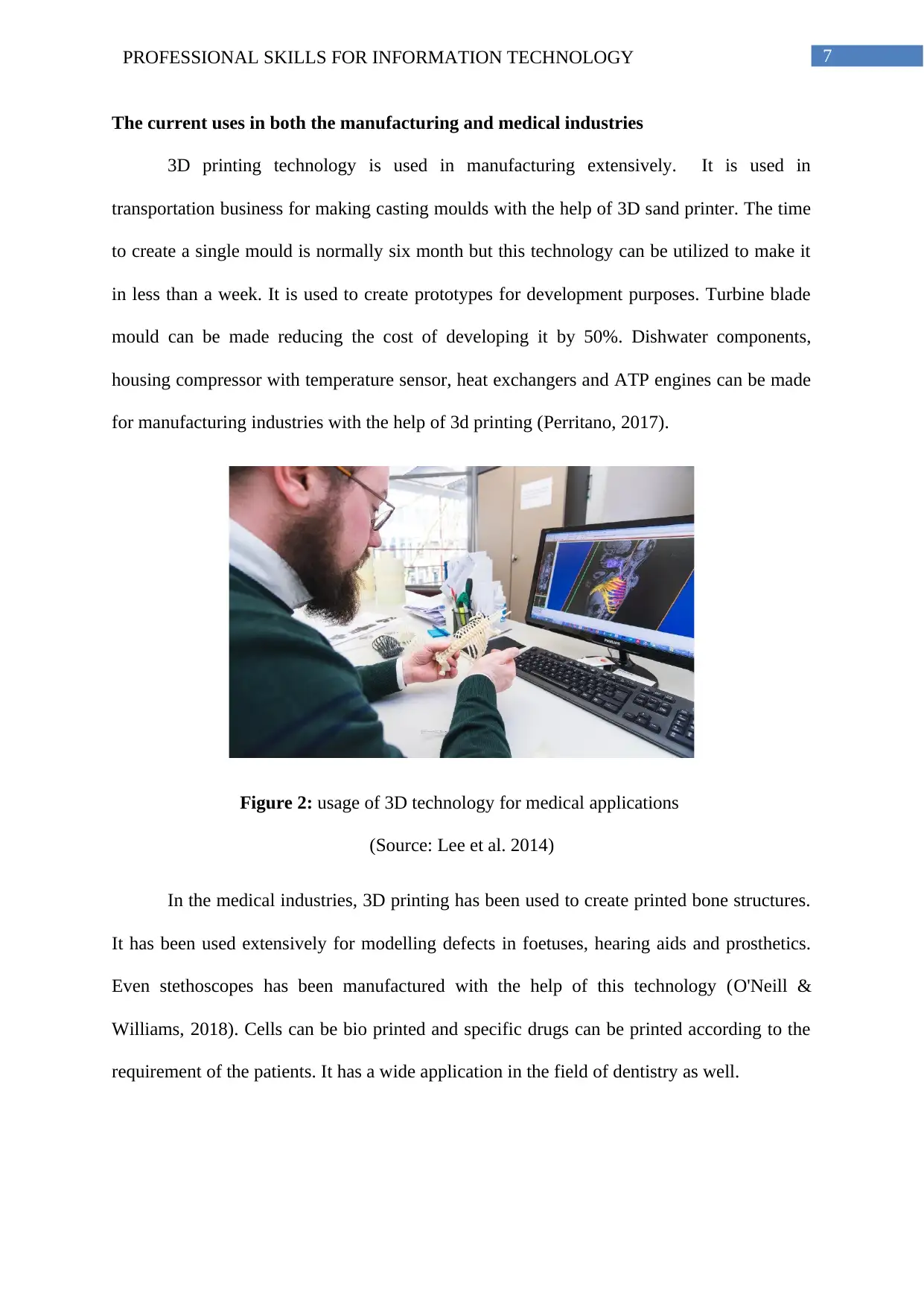
7PROFESSIONAL SKILLS FOR INFORMATION TECHNOLOGY
The current uses in both the manufacturing and medical industries
3D printing technology is used in manufacturing extensively. It is used in
transportation business for making casting moulds with the help of 3D sand printer. The time
to create a single mould is normally six month but this technology can be utilized to make it
in less than a week. It is used to create prototypes for development purposes. Turbine blade
mould can be made reducing the cost of developing it by 50%. Dishwater components,
housing compressor with temperature sensor, heat exchangers and ATP engines can be made
for manufacturing industries with the help of 3d printing (Perritano, 2017).
Figure 2: usage of 3D technology for medical applications
(Source: Lee et al. 2014)
In the medical industries, 3D printing has been used to create printed bone structures.
It has been used extensively for modelling defects in foetuses, hearing aids and prosthetics.
Even stethoscopes has been manufactured with the help of this technology (O'Neill &
Williams, 2018). Cells can be bio printed and specific drugs can be printed according to the
requirement of the patients. It has a wide application in the field of dentistry as well.
The current uses in both the manufacturing and medical industries
3D printing technology is used in manufacturing extensively. It is used in
transportation business for making casting moulds with the help of 3D sand printer. The time
to create a single mould is normally six month but this technology can be utilized to make it
in less than a week. It is used to create prototypes for development purposes. Turbine blade
mould can be made reducing the cost of developing it by 50%. Dishwater components,
housing compressor with temperature sensor, heat exchangers and ATP engines can be made
for manufacturing industries with the help of 3d printing (Perritano, 2017).
Figure 2: usage of 3D technology for medical applications
(Source: Lee et al. 2014)
In the medical industries, 3D printing has been used to create printed bone structures.
It has been used extensively for modelling defects in foetuses, hearing aids and prosthetics.
Even stethoscopes has been manufactured with the help of this technology (O'Neill &
Williams, 2018). Cells can be bio printed and specific drugs can be printed according to the
requirement of the patients. It has a wide application in the field of dentistry as well.
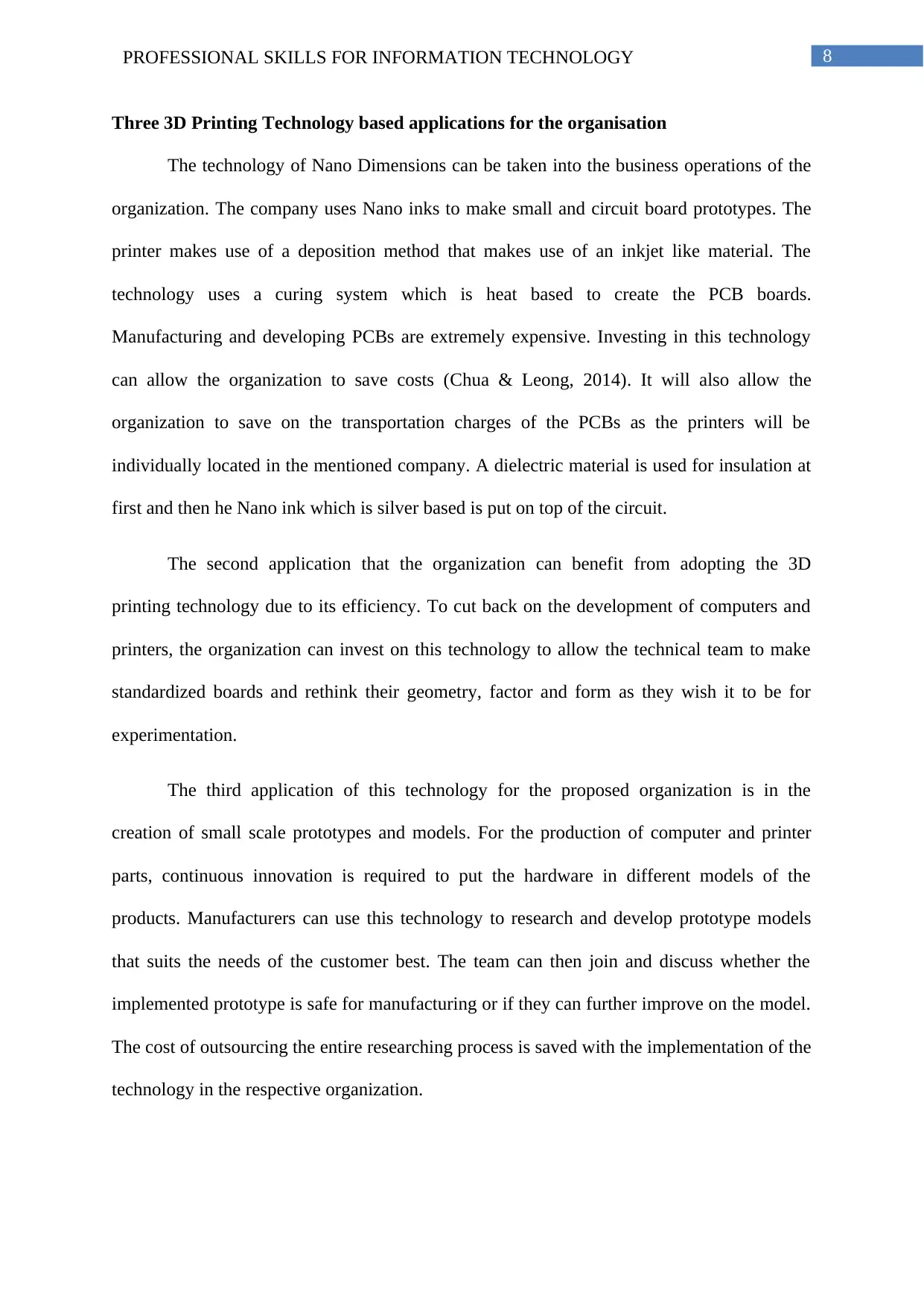
8PROFESSIONAL SKILLS FOR INFORMATION TECHNOLOGY
Three 3D Printing Technology based applications for the organisation
The technology of Nano Dimensions can be taken into the business operations of the
organization. The company uses Nano inks to make small and circuit board prototypes. The
printer makes use of a deposition method that makes use of an inkjet like material. The
technology uses a curing system which is heat based to create the PCB boards.
Manufacturing and developing PCBs are extremely expensive. Investing in this technology
can allow the organization to save costs (Chua & Leong, 2014). It will also allow the
organization to save on the transportation charges of the PCBs as the printers will be
individually located in the mentioned company. A dielectric material is used for insulation at
first and then he Nano ink which is silver based is put on top of the circuit.
The second application that the organization can benefit from adopting the 3D
printing technology due to its efficiency. To cut back on the development of computers and
printers, the organization can invest on this technology to allow the technical team to make
standardized boards and rethink their geometry, factor and form as they wish it to be for
experimentation.
The third application of this technology for the proposed organization is in the
creation of small scale prototypes and models. For the production of computer and printer
parts, continuous innovation is required to put the hardware in different models of the
products. Manufacturers can use this technology to research and develop prototype models
that suits the needs of the customer best. The team can then join and discuss whether the
implemented prototype is safe for manufacturing or if they can further improve on the model.
The cost of outsourcing the entire researching process is saved with the implementation of the
technology in the respective organization.
Three 3D Printing Technology based applications for the organisation
The technology of Nano Dimensions can be taken into the business operations of the
organization. The company uses Nano inks to make small and circuit board prototypes. The
printer makes use of a deposition method that makes use of an inkjet like material. The
technology uses a curing system which is heat based to create the PCB boards.
Manufacturing and developing PCBs are extremely expensive. Investing in this technology
can allow the organization to save costs (Chua & Leong, 2014). It will also allow the
organization to save on the transportation charges of the PCBs as the printers will be
individually located in the mentioned company. A dielectric material is used for insulation at
first and then he Nano ink which is silver based is put on top of the circuit.
The second application that the organization can benefit from adopting the 3D
printing technology due to its efficiency. To cut back on the development of computers and
printers, the organization can invest on this technology to allow the technical team to make
standardized boards and rethink their geometry, factor and form as they wish it to be for
experimentation.
The third application of this technology for the proposed organization is in the
creation of small scale prototypes and models. For the production of computer and printer
parts, continuous innovation is required to put the hardware in different models of the
products. Manufacturers can use this technology to research and develop prototype models
that suits the needs of the customer best. The team can then join and discuss whether the
implemented prototype is safe for manufacturing or if they can further improve on the model.
The cost of outsourcing the entire researching process is saved with the implementation of the
technology in the respective organization.
⊘ This is a preview!⊘
Do you want full access?
Subscribe today to unlock all pages.

Trusted by 1+ million students worldwide
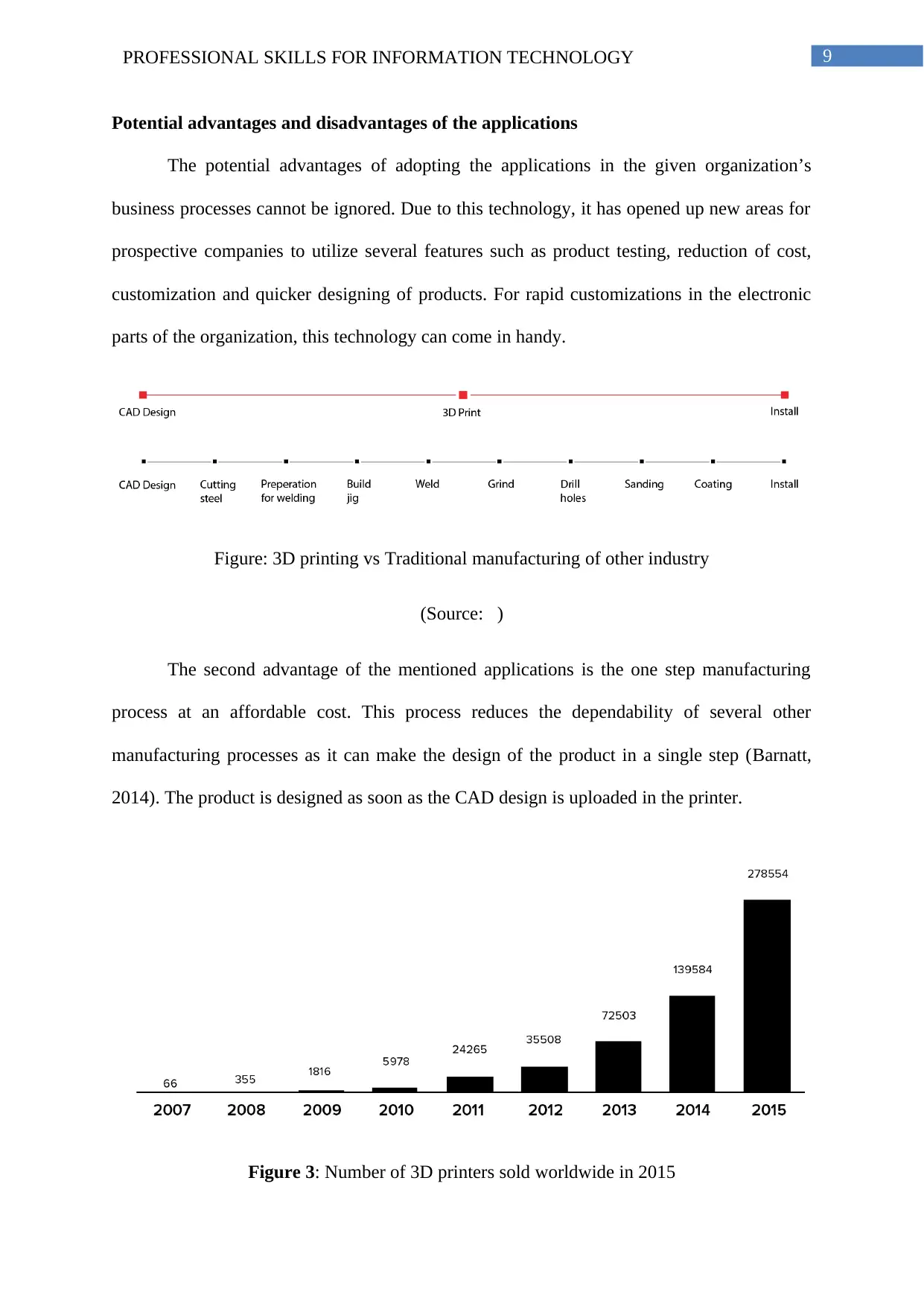
9PROFESSIONAL SKILLS FOR INFORMATION TECHNOLOGY
Potential advantages and disadvantages of the applications
The potential advantages of adopting the applications in the given organization’s
business processes cannot be ignored. Due to this technology, it has opened up new areas for
prospective companies to utilize several features such as product testing, reduction of cost,
customization and quicker designing of products. For rapid customizations in the electronic
parts of the organization, this technology can come in handy.
Figure: 3D printing vs Traditional manufacturing of other industry
(Source: )
The second advantage of the mentioned applications is the one step manufacturing
process at an affordable cost. This process reduces the dependability of several other
manufacturing processes as it can make the design of the product in a single step (Barnatt,
2014). The product is designed as soon as the CAD design is uploaded in the printer.
Figure 3: Number of 3D printers sold worldwide in 2015
Potential advantages and disadvantages of the applications
The potential advantages of adopting the applications in the given organization’s
business processes cannot be ignored. Due to this technology, it has opened up new areas for
prospective companies to utilize several features such as product testing, reduction of cost,
customization and quicker designing of products. For rapid customizations in the electronic
parts of the organization, this technology can come in handy.
Figure: 3D printing vs Traditional manufacturing of other industry
(Source: )
The second advantage of the mentioned applications is the one step manufacturing
process at an affordable cost. This process reduces the dependability of several other
manufacturing processes as it can make the design of the product in a single step (Barnatt,
2014). The product is designed as soon as the CAD design is uploaded in the printer.
Figure 3: Number of 3D printers sold worldwide in 2015
Paraphrase This Document
Need a fresh take? Get an instant paraphrase of this document with our AI Paraphraser
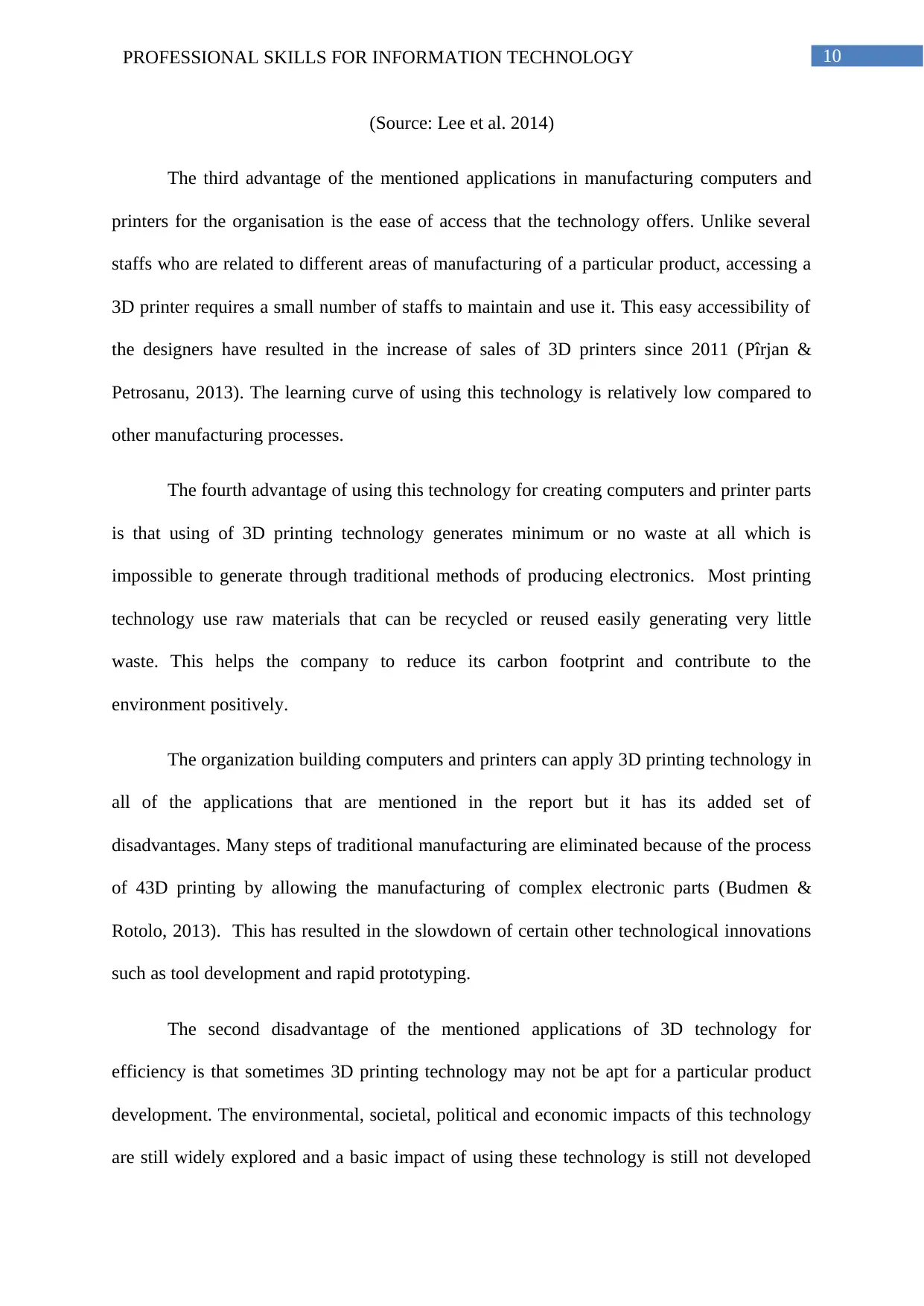
10PROFESSIONAL SKILLS FOR INFORMATION TECHNOLOGY
(Source: Lee et al. 2014)
The third advantage of the mentioned applications in manufacturing computers and
printers for the organisation is the ease of access that the technology offers. Unlike several
staffs who are related to different areas of manufacturing of a particular product, accessing a
3D printer requires a small number of staffs to maintain and use it. This easy accessibility of
the designers have resulted in the increase of sales of 3D printers since 2011 (Pîrjan &
Petrosanu, 2013). The learning curve of using this technology is relatively low compared to
other manufacturing processes.
The fourth advantage of using this technology for creating computers and printer parts
is that using of 3D printing technology generates minimum or no waste at all which is
impossible to generate through traditional methods of producing electronics. Most printing
technology use raw materials that can be recycled or reused easily generating very little
waste. This helps the company to reduce its carbon footprint and contribute to the
environment positively.
The organization building computers and printers can apply 3D printing technology in
all of the applications that are mentioned in the report but it has its added set of
disadvantages. Many steps of traditional manufacturing are eliminated because of the process
of 43D printing by allowing the manufacturing of complex electronic parts (Budmen &
Rotolo, 2013). This has resulted in the slowdown of certain other technological innovations
such as tool development and rapid prototyping.
The second disadvantage of the mentioned applications of 3D technology for
efficiency is that sometimes 3D printing technology may not be apt for a particular product
development. The environmental, societal, political and economic impacts of this technology
are still widely explored and a basic impact of using these technology is still not developed
(Source: Lee et al. 2014)
The third advantage of the mentioned applications in manufacturing computers and
printers for the organisation is the ease of access that the technology offers. Unlike several
staffs who are related to different areas of manufacturing of a particular product, accessing a
3D printer requires a small number of staffs to maintain and use it. This easy accessibility of
the designers have resulted in the increase of sales of 3D printers since 2011 (Pîrjan &
Petrosanu, 2013). The learning curve of using this technology is relatively low compared to
other manufacturing processes.
The fourth advantage of using this technology for creating computers and printer parts
is that using of 3D printing technology generates minimum or no waste at all which is
impossible to generate through traditional methods of producing electronics. Most printing
technology use raw materials that can be recycled or reused easily generating very little
waste. This helps the company to reduce its carbon footprint and contribute to the
environment positively.
The organization building computers and printers can apply 3D printing technology in
all of the applications that are mentioned in the report but it has its added set of
disadvantages. Many steps of traditional manufacturing are eliminated because of the process
of 43D printing by allowing the manufacturing of complex electronic parts (Budmen &
Rotolo, 2013). This has resulted in the slowdown of certain other technological innovations
such as tool development and rapid prototyping.
The second disadvantage of the mentioned applications of 3D technology for
efficiency is that sometimes 3D printing technology may not be apt for a particular product
development. The environmental, societal, political and economic impacts of this technology
are still widely explored and a basic impact of using these technology is still not developed
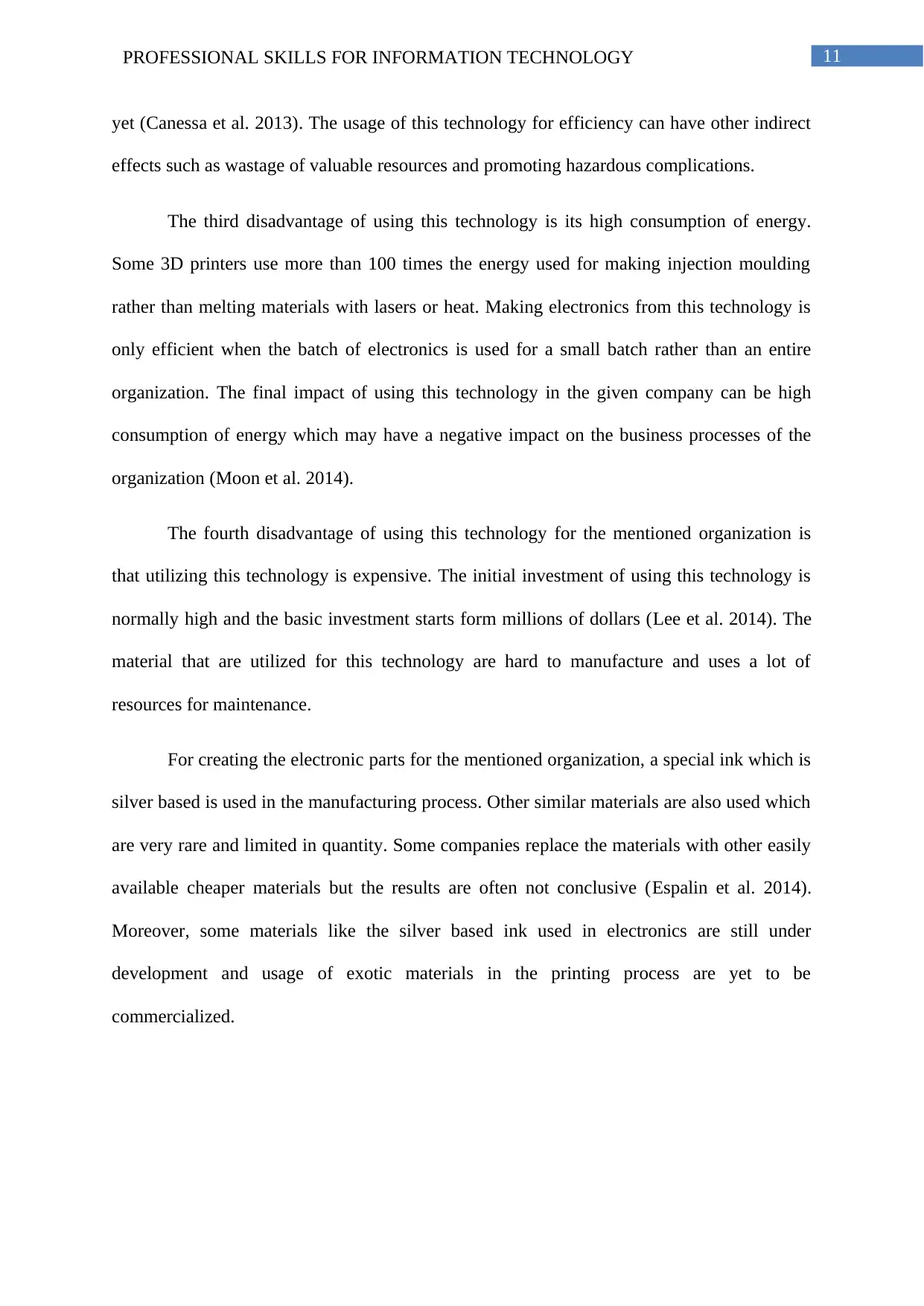
11PROFESSIONAL SKILLS FOR INFORMATION TECHNOLOGY
yet (Canessa et al. 2013). The usage of this technology for efficiency can have other indirect
effects such as wastage of valuable resources and promoting hazardous complications.
The third disadvantage of using this technology is its high consumption of energy.
Some 3D printers use more than 100 times the energy used for making injection moulding
rather than melting materials with lasers or heat. Making electronics from this technology is
only efficient when the batch of electronics is used for a small batch rather than an entire
organization. The final impact of using this technology in the given company can be high
consumption of energy which may have a negative impact on the business processes of the
organization (Moon et al. 2014).
The fourth disadvantage of using this technology for the mentioned organization is
that utilizing this technology is expensive. The initial investment of using this technology is
normally high and the basic investment starts form millions of dollars (Lee et al. 2014). The
material that are utilized for this technology are hard to manufacture and uses a lot of
resources for maintenance.
For creating the electronic parts for the mentioned organization, a special ink which is
silver based is used in the manufacturing process. Other similar materials are also used which
are very rare and limited in quantity. Some companies replace the materials with other easily
available cheaper materials but the results are often not conclusive (Espalin et al. 2014).
Moreover, some materials like the silver based ink used in electronics are still under
development and usage of exotic materials in the printing process are yet to be
commercialized.
yet (Canessa et al. 2013). The usage of this technology for efficiency can have other indirect
effects such as wastage of valuable resources and promoting hazardous complications.
The third disadvantage of using this technology is its high consumption of energy.
Some 3D printers use more than 100 times the energy used for making injection moulding
rather than melting materials with lasers or heat. Making electronics from this technology is
only efficient when the batch of electronics is used for a small batch rather than an entire
organization. The final impact of using this technology in the given company can be high
consumption of energy which may have a negative impact on the business processes of the
organization (Moon et al. 2014).
The fourth disadvantage of using this technology for the mentioned organization is
that utilizing this technology is expensive. The initial investment of using this technology is
normally high and the basic investment starts form millions of dollars (Lee et al. 2014). The
material that are utilized for this technology are hard to manufacture and uses a lot of
resources for maintenance.
For creating the electronic parts for the mentioned organization, a special ink which is
silver based is used in the manufacturing process. Other similar materials are also used which
are very rare and limited in quantity. Some companies replace the materials with other easily
available cheaper materials but the results are often not conclusive (Espalin et al. 2014).
Moreover, some materials like the silver based ink used in electronics are still under
development and usage of exotic materials in the printing process are yet to be
commercialized.
⊘ This is a preview!⊘
Do you want full access?
Subscribe today to unlock all pages.

Trusted by 1+ million students worldwide
1 out of 17
Related Documents
Your All-in-One AI-Powered Toolkit for Academic Success.
+13062052269
info@desklib.com
Available 24*7 on WhatsApp / Email
![[object Object]](/_next/static/media/star-bottom.7253800d.svg)
Unlock your academic potential
Copyright © 2020–2025 A2Z Services. All Rights Reserved. Developed and managed by ZUCOL.



